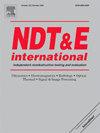Accurate monitoring of additive manufacturing quality using non-specular reflection of bounded ultrasonic beams
IF 4.1
2区 材料科学
Q1 MATERIALS SCIENCE, CHARACTERIZATION & TESTING
引用次数: 0
Abstract
This study introduces a viable methodology that leverages the phenomenon of non-specular reflection of bounded ultrasonic beams within a liquid-solid plate-liquid configuration to precisely monitor the quality of components produced through additive manufacturing (AM). The investigation delves into the relationship between non-specular reflection and some key parameters, including the degradation of AM components' quality and the incident angle of bounded ultrasonic beams. Through a detailed exploration of the propagation behaviors of bounded ultrasonic beams within a water-AM components-water configuration via finite element (FE) simulations, it becomes evident that the specular reflection coefficient (SRC) serves as a pivotal indicator of the non-specular reflection phenomenon. Notably, the simulation results indicate that the change rate of SRC at the S0 critical angle (CRS0) reveals a significant, monotonically increasing sensitivity to the degradation in the quality of AM components. This discovery unveils a robust approach for precisely monitoring the quality of AM components. Furthermore, the experimental result also demonstrates that the parameter CRS0 exhibits highly sensitive characteristics to the degradation in the quality of AM components when a bounded ultrasonic beam is incident at the S0 critical angle onto the AM components. Concurrently, the presence of irregular holes on the surface of AM components, as shown by the metallographic analysis result, substantiates the effectiveness of the parameter CRS0. This investigation affirms that the CRS0-based method is a feasible non-destructive evaluation one for accurately monitoring the quality of AM components.
求助全文
约1分钟内获得全文
求助全文
来源期刊

Ndt & E International
工程技术-材料科学:表征与测试
CiteScore
7.20
自引率
9.50%
发文量
121
审稿时长
55 days
期刊介绍:
NDT&E international publishes peer-reviewed results of original research and development in all categories of the fields of nondestructive testing and evaluation including ultrasonics, electromagnetics, radiography, optical and thermal methods. In addition to traditional NDE topics, the emerging technology area of inspection of civil structures and materials is also emphasized. The journal publishes original papers on research and development of new inspection techniques and methods, as well as on novel and innovative applications of established methods. Papers on NDE sensors and their applications both for inspection and process control, as well as papers describing novel NDE systems for structural health monitoring and their performance in industrial settings are also considered. Other regular features include international news, new equipment and a calendar of forthcoming worldwide meetings. This journal is listed in Current Contents.
 求助内容:
求助内容: 应助结果提醒方式:
应助结果提醒方式:


